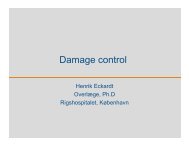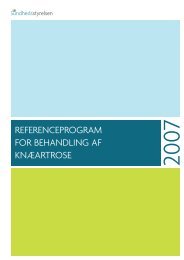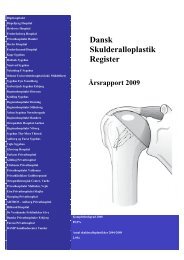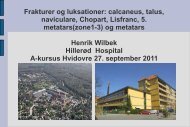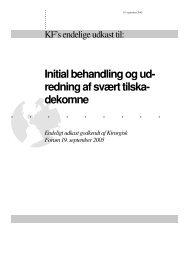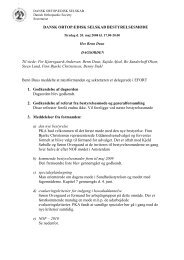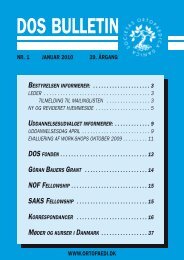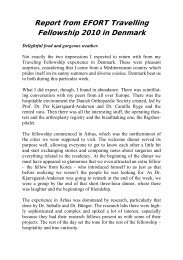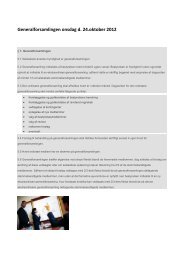DOS BULLETIN - Dansk Ortopædisk Selskab
DOS BULLETIN - Dansk Ortopædisk Selskab
DOS BULLETIN - Dansk Ortopædisk Selskab
You also want an ePaper? Increase the reach of your titles
YUMPU automatically turns print PDFs into web optimized ePapers that Google loves.
2010-378_<strong>DOS</strong> nr. 3 2010 29/09/10 10:08 Side 87<br />
Glenoid Morphology in Obstetrical Plexus Brachialis<br />
Lesions<br />
A 3-D CT study<br />
Pernille Madsen, Trine Torfing, Keld Daubjerg, Lars Frich<br />
Dept of Orthopaedics & Dept of radiology, Odense University Hospital<br />
Background: Glenohumeral weakness is common after Obstetrical<br />
Brachial Plexus Lesion (OBPL). A fixed contracture often develops over<br />
time that has a deleterious effect on the glenohumeral joint development.<br />
Purpose: The purpose of this study was to describe the 3-dimensional<br />
morphology of the glenoid cavity in children with OBPL.<br />
Methods: Between October 2004 and May 2008 33 children with an<br />
average age of 8 years (4 – 16) were treated at Odense University Hospital.<br />
Shoulder function was assessed using the Mallet Score. Preoperative<br />
CT-scans of 27 Scapulae were available for this study. A reconstruction<br />
algorithm was used in processing the images. We measured Glenoid<br />
height, width, 2D and 3D glenoid version, inclination and spino-glenoid<br />
angle. A qualitative description of the shape of the glenoid was also<br />
made.<br />
Findings: The glenoid version on the affected side averaged -19º (2D)<br />
and -7º (3D). The inclination was 68º on the affected shoulders and 65º<br />
on the normal shoulders. Thirteen of the affected shoulders had normal<br />
Glenoid shape and 14 CT scans revealed dysplacia. Eleven (11) glenoids<br />
had a diamond shape and the articulation was shifted towards a posterior/inferior<br />
position i 3 children. The mean preoperative Mallet score was<br />
10.4 (range 6-15). Negative correlation was found between Mallet score<br />
and the posterior width of the glenoid (corr coef = -0.548, p=0.019), and<br />
inclination angle (corr coef = -0.650, p=0.005).<br />
Conclusion: This is the first study to document the 3D morphology of<br />
the glenoid in children with OPBL. The 2D scans tended to overestimate<br />
glenoid retroversion. 3D scans revealed a diamond shape of the glenoid<br />
cavity in 14 shoulders. This study showed superiority of 3D-CT scans for<br />
evaluation of glenoid dysplacia<br />
87



